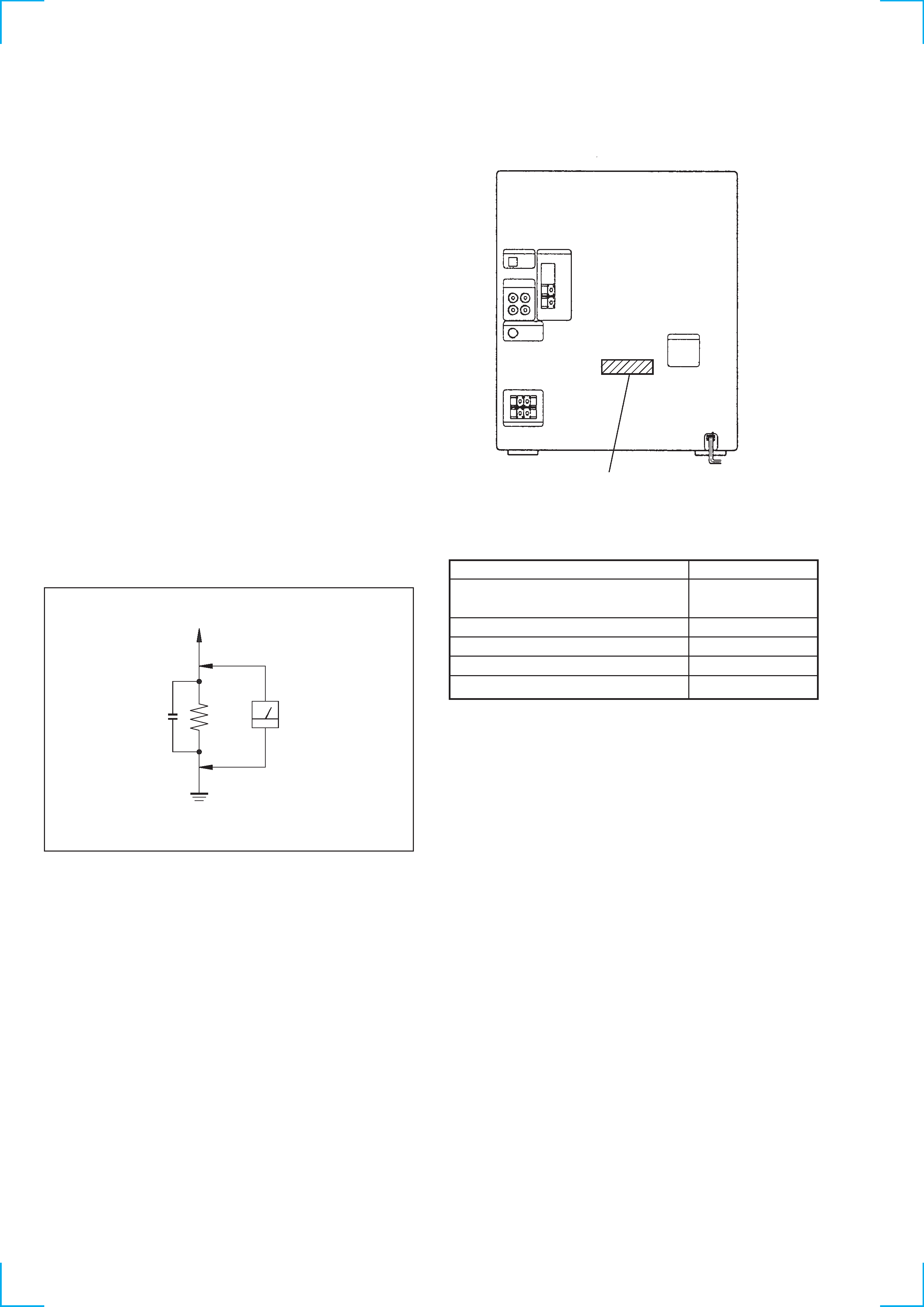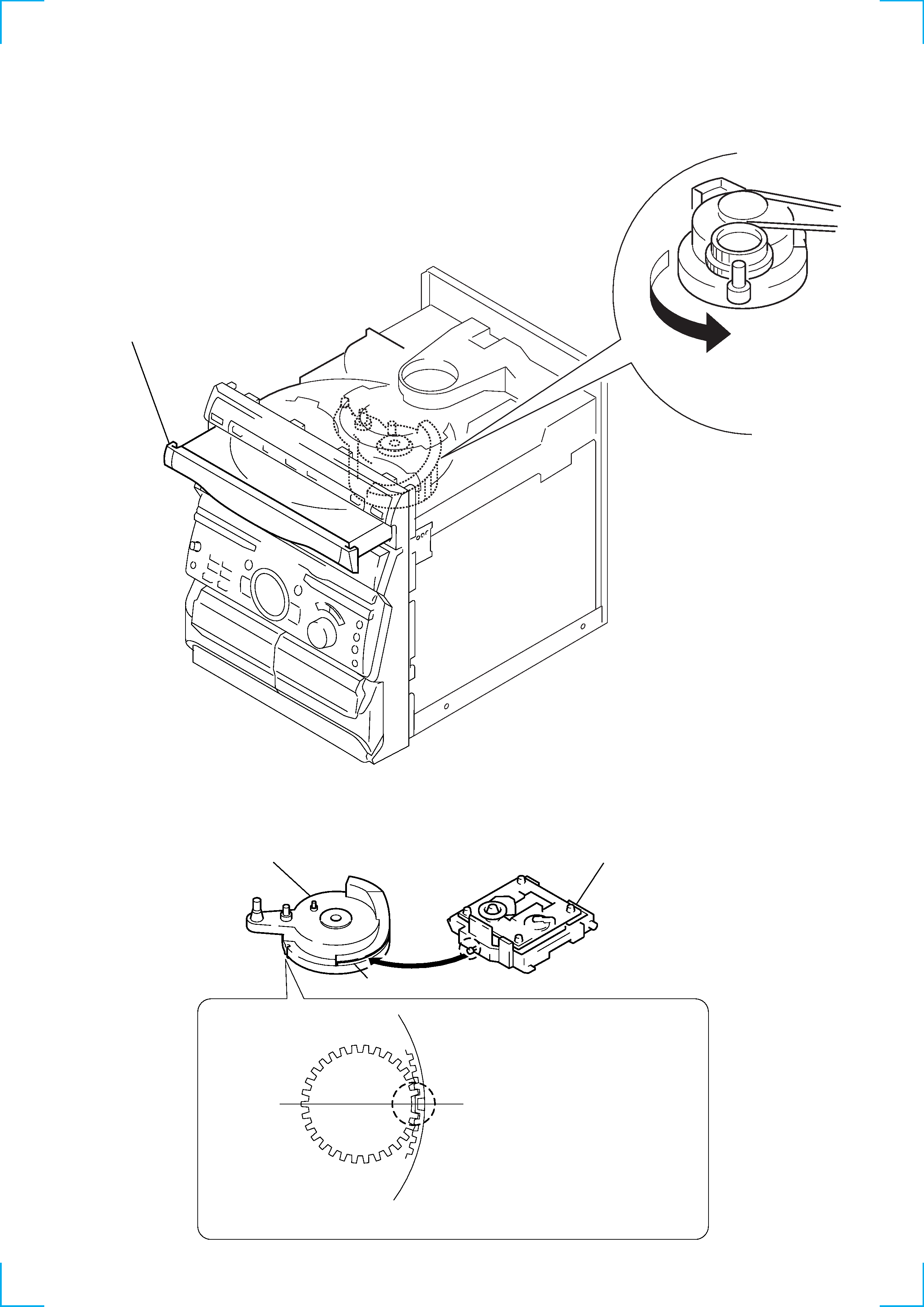
HCD-GRX30/GRX30J/R550/RXD5
US Model
Canadian Model
HCD-RXD5
AEP Model
UK Model
HCD-R550/RXD5
E Model
HCD-GRX30/GRX30J
Australian Model
HCD-GRX30
Tourist Model
HCD-GRX30J
SERVICE MANUAL
MINI Hi-Fi COMPONENT SYSTEM
MICROFILM
Manufactured under license from Dolby Laboratories
Licensing Corporation.
"DOLBY" and the double-D symbol
aare trademarks
of Dolby Laboratories Licensing Corporation.
HCD-GRX30/GRX30J/R550/RXD5 is
the Amplifier, CD player, Tape Deck and
Tuner section in MHC-GRX30/GRX30J/
R550/RXD5
-- Continued on next page --
SPECIFICATIONS
Model Name Using Similar Mechanism
HCD-GRX5/RX66
CD Mechanism Type
CDM38LH-5BD32L
Base Unit Type
BU-5BD32L
Optical Pick-up Type
KSS-213D/Q-RP
Model Name Using Similar Mechanism
HCD-GRX5
Tape Transport Mechanism Type
TCM-230AWR2
CD
Section
TAPE
DECK
Section
AUDIO POWER SPECIFICATIONS:
POWER OUTPUT AND TOTAL
HARMONIC DISTORTION
US model:
with 6 ohm loads both channels driven, from 70 -
20,000 Hz; rates 60 watts per channel minimum RMS
power, with no more than 0.9% total harmonic
distortion from 250 milliwatts to rated output.
Amplifier section
North American model:
Continuous RMS power output (reference)
60 + 60 W
(6
at 1 kHz, 10% THD)
European model:
DIN power output (rated) 60 + 60 W
(6
at 1 kHz, DIN)
Continuous RMS power output (reference)
80 + 80 W
(6
at 1 kHz, 10% THD)
Music power output (reference)
140 + 140 W
(6
at 1kHz, 10% THD)
Other models:
The following measured at AC 110, 220 V 50/60 Hz
DIN power output (rated)60 + 60 W
(6
at 1 kHz, DIN)
Continuous RMS power output (reference)
80 + 80 W
(6
at 1 kHz, 10% THD)
The following measured at AC 120, 240 V 50/60 Hz
DIN power output (rated)70 + 70 W
(6
at 1 kHz, DIN)
Continuous RMS power output (reference)
100 + 100 W
(6
at 1 kHz, 10% THD)
Inputs
MD/VIDEO (AUDIO) IN:
(phono jacks)
voltage 450 mV/250mV,
impedance 47 k
MIX MIC: (phone jack) sensitivity 1 mV,
impedance 10 k
Outputs
MD/VIDEO (AUTO) OUT:
(phono jack)
voltage 250 mV
impedance 1 k
PHONES:
accepts headphones of 8
(stereo mini jack)
or more
SPEAKER:
accepts impedance of 6 to
16
SUPER WOOFER
(except for European model):
Voltage 1V, impedance 1k
CD player section
System
Compact disc and digital audio
system
Laser
Semiconductor laser (
=780nm)
Emission duration: continuous
Laser output
Max. 44.6 µW*
*This output is the value
measured at distance of 200 mm
from the objective lens surface on
the Optical Pick-up Block with 7
mm aperture.
Frequency response
2 Hz - 20 kHz (±0.5 dB)
Wavelength
780 -790 nm
Signal-to-noise ratio
More than 85 dB
Dynamic range
More than 85 dB
CD OPTICAL DIGITAL OUT
(Square optical connector jack, rear panel)
Wavelength
600 nm
Output Level
18 dBm
Photo: HCD-GRX30

-- 2 --
Tape player section
Recording system
4-track 2-channel stereo
Frequency response
40 - 13,000 Hz (±3 dB),
(DOLBY NR OFF)
using Sony TYPE I cassette
40 - 14,000 Hz (±3 dB),
using Sony TYPE II cassette
Tuner section
FM stereo, FM/AM superheterodyne tuner
FM tuner section
Tuning range
87.5 - 108.0 MHz
Antenna
FM lead antenna
Antenna terminals
75
unbalanced
Intermediate frequency 10.7 MHz
AM tuner section
Tuning range
2 Band type:
North American models: 530 - 1,710 kHz
(with the interval set at 10 kHz)
531 - 1,710 kHz
(with the interval set at 9 kHz)
European model:
531 1,602 kHz
(with the interval set at 9 kHz)
Other models:
531 - 1,602 kHz
(with the interval set at 9 kHz)
530 - 1,710 kHz
(with the interval set at 10 kHz)
3 Band type:
Middle Eastern model:
MW:
531 1,602 kHz
(with the interval set at 9 kHz)
SW:
5.95 17.90 MHz
(with the interval set at 5 kHz)
Other models:
MW:
531 1,602 kHz
(with the interval set at 9 kHz)
530 1,710 kHz
(with the interval set at 10 kHz)
SW:
5.95 1,790 kHz
(with the interval set at 5 kHz)
Antenna
AM loop antenna
Antenna terminals
External antenna terminal
Intermediate frequency 450 kHz
General
Power requirements
North American model:
120 V AC, 60 Hz
European model:
230 V AC, 50/60Hz
Australian model:
230 240 V AC, 50/60 Hz
Mexican model:
120 V AC, 50/60 Hz
Thailand model:
220 - 240 V AC, 50/60 Hz
Other models:
110 - 120 V or 220 - 240 V AC,
50/60 Hz
Power consumption
U.S.A. model:
130 W
Canadian model:
110 W
East European model:
130W
Other models:
110 W
Dimensions (w/h/d)
Approx. 280
× 340 × 380 mm
(11
× 133/8 × 15 in.)
Mass:
Approx. 9.5 kg (21 lb.)
Supplied accessories:
AM loop antenna (1)
Remote commander (1)
Batteries (2)
FM lead antenna (1)
Speaker cords (2) (for European model only)
Design and specifications are subject to change without notice.

-- 3 --
SECTION 1
SERVICING NOTES
The laser diode in the optical pick-up block may suffer electrostatic
break-down because of the potential difference generated by the
charged electrostatic load, etc. on clothing and the human body.
During repair, pay attention to electrostatic break-down and also
use the procedure in the printed matter which is included in the
repair parts.
The flexible board is easily damaged and should be handled with
care.
NOTES ON LASER DIODE EMISSION CHECK
The laser beam on this model is concentrated so as to be focused on
the disc reflective surface by the objective lens in the optical pick-
up block. Therefore, when checking the laser diode emission,
observe from more than 30 cm away from the objective lens.
Notes on chip component replacement
· Never reuse a disconnected chip component.
· Notice that the minus side of a tantalum capacitor may be dam-
aged by heat.
Flexible Circuit Board Repairing
· Keep the temperature of the soldering iron around 270 °C dur-
ing repairing.
· Do not touch the soldering iron on the same conductor of the
circuit board (within 3 times).
· Be careful not to apply force on the conductor when soldering
or unsoldering.
NOTES ON HANDLING THE OPTICAL PICK-UP
BLOCK OR BASE UNIT
CAUTION
Use of controls or adjustments or performance of procedures
other than those specified herein may result in hazardous
radiation exposure.
This appliance is classified as a CLASS 1 LASER product.
The CLASS 1 LASER PRODUCT MARKING is located on
the rear exterior.
Laser component in this product is capable of emitting radiation
exceeding the limit for Class 1.
The following caution label is located inside the unit.
1.
SERVICING NOTES ··················································· 3
2.
GENERAL ······································································ 6
3.
DISASSEMBLY
3-1.
Case ···················································································· 8
3-2.
Front Panel Section ···························································· 8
3-3.
Tape Mechanism Deck Section (TCM-230AWR2) ············ 9
3-4.
CD Mechanism Deck section (CDM38LH-5BD32L) ········ 9
3-5.
Main Board ······································································· 10
4.
TEST MODE ································································ 11
5.
MECHANICAL ADJUSTMENTS ·························· 13
6.
ELECTRICAL ADJUSTMENTS ··························· 13
7.
DIAGRAMS
7-1.
Circrit Boards Location ···················································· 18
7-2.
Block Diagrams ································································ 19
· CD Section····································································· 19
· Tape Deck Section ························································· 21
· Main Section ·································································· 23
· Display/Key Con Section ·············································· 25
7-3.
Printed Wiring Board CD Section ······························ 29
7-4.
Schematic Diagram CD Section ·································· 31
7-5.
Printed Wiring Board CD Motor Section ··················· 33
7-6.
Schematic Diagram CD Motor Section ······················ 35
7-7.
Printed Wirint Board Tape Deck Section ··················· 37
7-8.
Schematic Diagram Tape Deck Section ····················· 39
7-9.
Printed Wiring Board Leaf SW Section ····················· 41
7-10. Schematic Diagram Leaf SW Section ························ 42
7-11. Printed Wiring Board Main Section ··························· 43
7-12. Schematic Diagram Main Section (1/4) ····················· 45
7-13. Schematic Diagram Main Section (2/4) ····················· 47
7-14. Schematic Diagram Main Section (3/4) ····················· 49
7-15. Schematic Diagram Main Section (4/4) ····················· 51
7-16. Printed Wiring Board Panel Section ··························· 53
7-17. Schematic Diagram Panel Section ····························· 55
7-18. Printed Wiring Board AC Sec Standby Section ·········· 57
7-19. Schematic Diagram AC Sec Standby Section ············ 59
7-20. Printed Wiring Board CD SW Section ······················· 61
7-21. Schematic Diagram CD SW Section ·························· 61
7-22. IC Block Diagrams ··························································· 63
7-23. IC PIN Function Description ············································ 66
8.
EXPLODED VIEWS
8-1.
Case Section ····································································· 69
8-2.
Front Panel Section ·························································· 70
8-3.
Chassis Section ································································· 71
8-4.
CD Mechanism Deck Section-1 (CDM38LH-5BD32L) ·· 73
8-5.
CD Mechanism Deck Section-2 (CDM38LH-5BD32L) ·· 74
8-6.
Base Unit Section (BU-5BD32L) ····································· 75
8-7.
Tape Mechanism Deck Section-1 (TCM-230AWR2) ······ 76
8-8.
Tape Mechanism Deck Section-2 (TCM-230AWR2) ······ 77
9.
ELECTRICAL PARTS LIST ··································· 78
TABLE OF CONTENTS

-- 4 --
SAFETY-RELATED COMPONENT WARNING!!
COMPONENTS IDENTIFIED BY MARK
! OR DOTTED LINE WITH
MARK
! ON THE SCHEMATIC DIAGRAMS AND IN THE PARTS
LIST ARE CRITICAL TO SAFE OPERATION. REPLACE THESE
COMPONENTS WITH SONY PARTS WHOSE PART NUMBERS
APPEAR AS SHOWN IN THIS MANUAL OR IN SUPPLEMENTS
PUBLISHED BY SONY.
ATTENTION AU COMPOSANT AYANT RAPPORT
À LA SÉCURITÉ!
LES COMPOSANTS IDENTIFÉS PAR UNE MARQUE
! SUR LES
DIAGRAMMES SCHÉMATIQUES ET LA LISTE DES PIÈCES SONT
CRITIQUES POUR LA SÉCURITÉ DE FONCTIONNEMENT. NE
REMPLACER CES COMPOSANTS QUE PAR DES PIÈSES SONY
DONT LES NUMÉROS SONT DONNÉS DANS CE MANUEL OU
DANS LES SUPPÉMENTS PUBLIÉS PAR SONY.
After correcting the original service problem, perform the
following safety checks before releasing the set to the customer:
Check the antenna terminals, metal trim, "metallized" knobs, screws,
and all other exposed metal parts for AC leakage. Check leakage as
described below.
LEAKAGE
The AC leakage from any exposed metal part to earth ground
and from all exposed metal parts to any exposed metal part having
a return to chassis, must not exceed 0.5 mA (500 microamperes).
Leakage current can be measured by any one of three methods.
1.
A commercial leakage tester, such as the Simpson 229 or RCA
WT-540A. Follow the manufacturers' instructions to use these
instruments.
2.
A battery-operated AC milliammeter. The Data Precision 245
digital multimeter is suitable for this job.
3.
Measuring the voltage drop across a resistor by means of a
VOM or battery-operated AC voltmeter. The "limit" indication
is 0.75 V, so analog meters must have an accurate low-voltage
scale. The Simpson 250 and Sanwa SH-63Trd are examples of
a passive VOM that is suitable. Nearly all battery operated
digital multimeters that have a 2V AC range are suitable. (See
Fig. A)
SAFETY CHECK-OUT
To Exposed Metal
Parts on Set
0.15
µF
1.5 k
AC
Voltmeter
(0.75 V)
Earth Ground
Fig. A. Using an AC voltmeter to check AC leakage.
PART No.
MODEL IDENTIFICATION
Back Panel
MODEL
GRX30: E2, E3, EA, AR, SP, TW models
GRX30J models
R550, RXD5: CIS models
RXD5: US, CND models
R550, RXD5: AEP, AED, UK, G models
GRX30: MX, TH, KR, AUS models
PART No.
4-214-432-0
4-214-432-1
4-214-432-2
4-214-432-3
4-214-432-6
· Abbreviation
CND : Canadian model
AUS : Australian model
G
: German model
AED : North European model
EA
: Saudi Arabia model
E2
: Central and South America model
E3
: Middle and Near East model
MX
: Mexican model
SP
: Singapore model
TH
: Thai model
TW
: Taiwan model
AR
: Argentina model
KR
: Korea model

-- 5 --
1 Remove the Case.
3 Pull-out the disc tray.
2 Turn the cam to the
direction of arrow.
BU cam
Groove
Section A
Note:When attaching the Base unit, Insert the
section A into the groove of BU cam.
Note:When attaching the BU cam,
engage the Rotary encoder
switch as shown in the figure.
HOW TO OPEN THE DISC TRAY WHEN POWER SWITCH TURNS OFF.
NOTE FOR INSTALLATION (ROTARY ENCODER)
